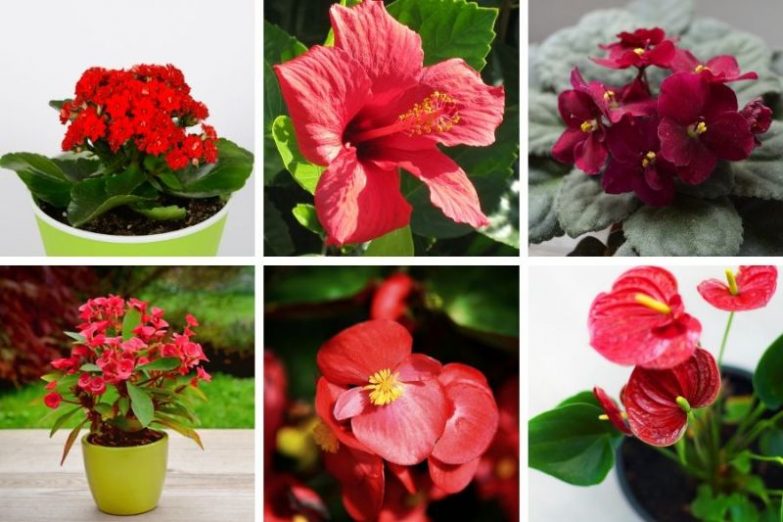One of the best things about houseplants is the seemingly endless varieties available, to bring your home to life. Tall, short, trailing, upright, and such a variety of colors! While our first instinct is to think about the green component they add to our space, the variety of flower colors available adds an extra element and pop of color. This article covers some of my favorite houseplants with red flowers, that can brighten any space.
15 Beautiful Houseplants With Red Flowers
These 15 houseplants with red flowers range in size and shape, and the list includes some really easy to care for plants and several that require a bit more work, but have an amazing payout when they bloom. Since red is the color of energy, strength, passion, and love, these houseplants are perfect for your home.
African Violets (Saintpaulia ionantha)
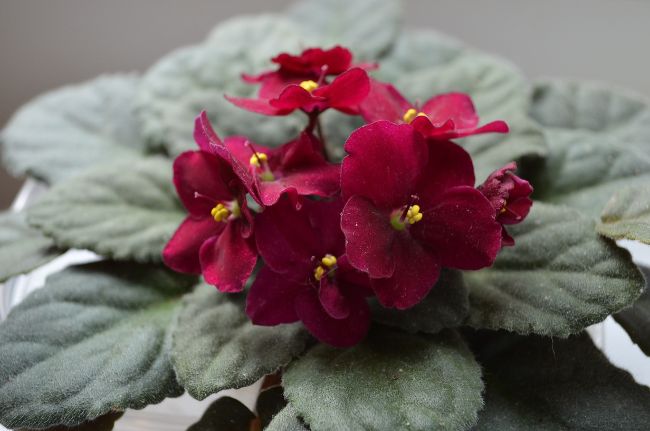
Psssttt…want to hear a secret? African violets come in colors other than purple! You can buy them in varieties of blue, red, pink, and white. While the red varieties make up a much smaller percentage of the 2000 plus cultivars, they do exist, and they are unexpectedly gorgeous when they bloom.
African violets are some of the most commonly grown indoor flowering plants, and for good reason. These compact beauties are perfectly suited for growing on a windowsill. Plants like medium to bright, indirect light but will bloom even in low light conditions.
Allow the soil to dry out slightly between waterings; then water thoroughly making sure to avoid getting moisture on the foliage. When the fuzzy leaves become dirty use a small paintbrush to gently brush debris away. I’ve written an article about how to keep your African Violets blooming all year, to help keep yours looking its best.
Amaryllis (Hippeastrum spp.)
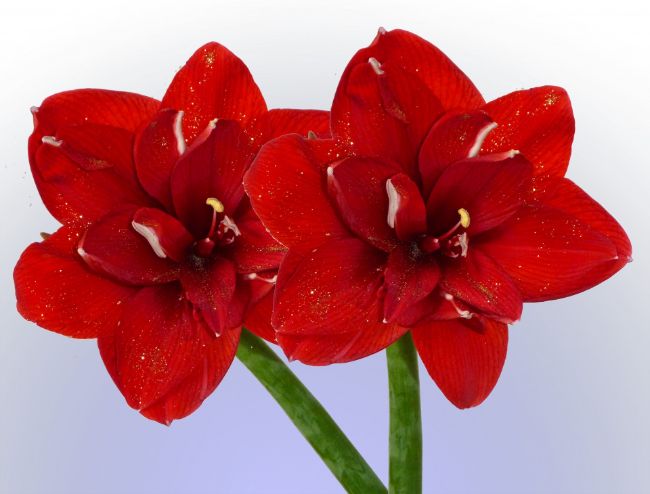
One of the most popular indoor-grown bulb plants, Amaryllis is a holiday favorite, brightening Christmas and Valentine’s Day with its beautiful clusters of fragrant flowers, which look fantastic in red. Bare bulbs are planted to produce well-timed blooms to be gifted to others on the Christmas holiday, brightening the shortest days of the year.
Amaryllis are typically treated as annual plants when gifted and discarded after they finish blooming. As a bulb plant though they can be forced to bloom year after year as a perennial.
After flowering cut the flower stalks an inch or two above the bulb and place the container back in a sunny windowsill to deplete the nutrient reserves in the bulb. Come autumn, place the bulbs in a dark, cool location for about 8 weeks to force them into dormancy, bringing them out in time to bloom again in December.
Christmas Cactus (Schlumbergera truncata)
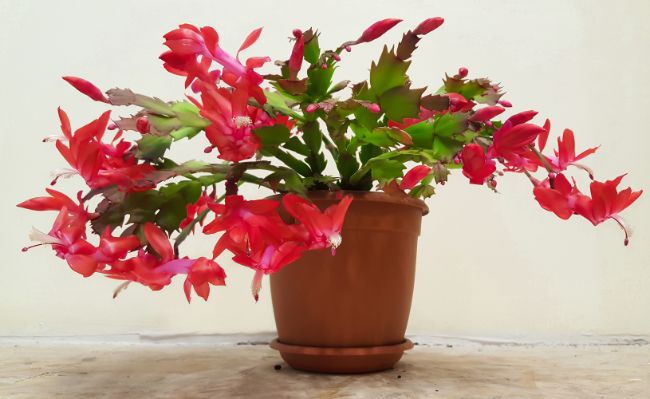
Unlike the spine-covered Desert Cacti, the Christmas Cactus is native to forests and woodlands where plants grow attached to trees. Branching, arching stems with flat leaf-life segments make it perfect for growing in hanging baskets or a location where the foliage can trail downward.
Plants bloom between mid-November and January and are typically purchased before Christmas when they are in bloom or about to. For the notice growers, flowers are a one and done occurrence but under the care of an experienced gardener, they can be forced to flower again if placed in a cool, dark area and given little or no water to initiate new flower buds.
Crown of Thorns Plant (Euphorbia milii)
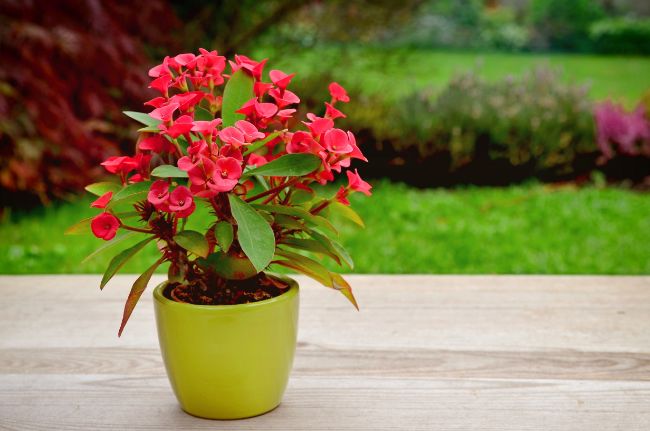
Also known as the Christ Plant or Corona de Cristo in Latin America, the Crown of Thorns plant gets its name from the sharp, inch-long black spines that adorn the stems, thought to be used for the crown of thorns worn by Jesus Christ at the time of the crucifixion.
This sprawling evergreen has leathery, obovate green leaves and tiny, inconspicuous yellow flowers surrounded by showy, long-lasting, red flowers. Indoor plants will bloom from late winter all the way through the fall when conditions are good.
Like other succulents, wait to water your plants until the top inch of the potting soil is dry and then water thoroughly. Crown of Thorns plants prefer 3 to 4 hours of direct light every day and do best in temperatures between 65°F (18°C) – 90°F (32°C). Read more about how to care for Crown of Thorns plant here.
Cyclamen (Cyclamen persicum)
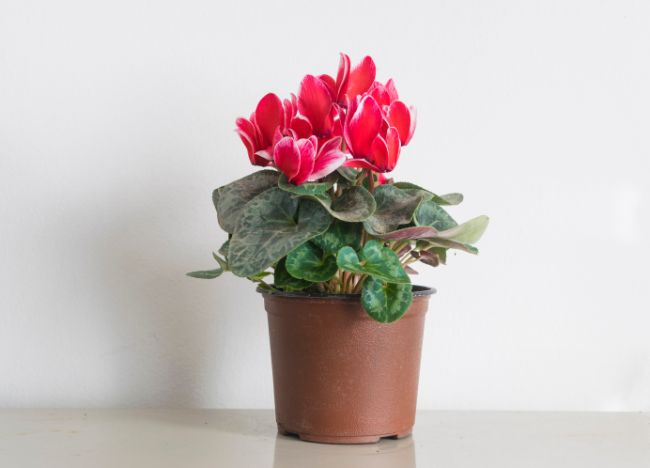
A popular winter-flowering plant, cyclamen are known for their compact growth, beautiful flowers, and decorative foliage. Depending on the variety chosen plants grow from 6 to 12-inches tall, and are adorned with leaves intricately patterned with shades of silver and green. Blooms can be brightly colored or shades of pastels, and range in size from large, eye-catching displays to small, highly perfumed blossoms.
While plants are in bloom keep the rootball moist without overwatering to prevent fungal problems or root rot. Plants benefit from being grown in a well-draining growing media. Water from the bottom, either placing the cyclamen in a sink full of water or keeping it in a tray that can be filled. Avoid getting water on the leaves and stem of the plant to avoid damage or fungal growth. Cyclamen prefer temps in the low 60s and bright, indirect light.
Flaming Katy (Kalanchoe blossfeldiana)
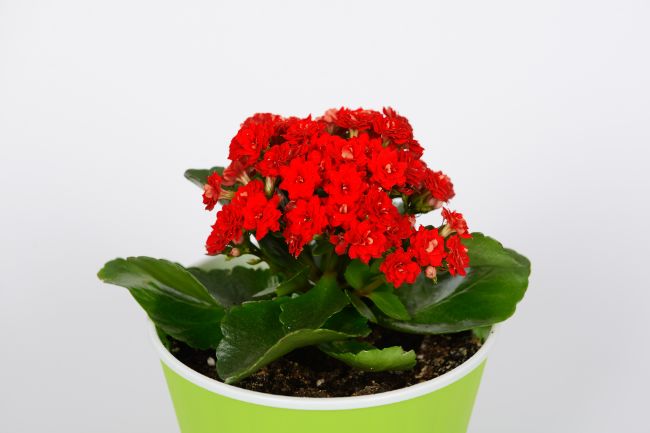
The Flaming Katy plants are the most popular succulents grown in the Kalanchoe family, and probably the most common houseplants with red flowers. Popular not only for the large, dark-green fleshy leaves but its diminutive flowers that blossom in masses. Plants typically flower only once a year but they can be forced to bloom again by giving them 12-14 hours of total darkness every day for 6 to 8 weeks.
They are very sensitive to cold so keep them in a spot where the ambient temperature lies between 65°F (18°C) – 80°F (26°C), protecting them especially from drafty windows and air conditioning vents.
Let the potting mix dry out between waterings and avoid getting water on the foliage when you water. You can also carefully remove some of the upper leaves if they are blocking the view of the plant’s flowers. Read my guide to caring for Kalanchoe blossfeldiana here.
Flaming Sword (Vriesea splendens)
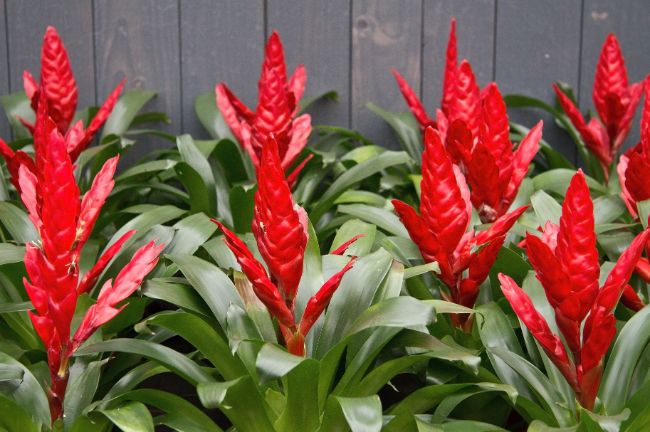
Another member of the Bromeliad family to make this list, the Flaming Sword plant is one of the most popular bromeliads grown indoors. They can be found growing as epiphytes in nature and can be grown indoors attached to a slab of bark versus in a container with potting soil.
The tall, narrow flower spike can grow upwards of 30-inches tall and will last from 2 to 4-months after appearing. Keep the cup reservoir filled with clean water, and provide a warm, moist environment for plants that receives bright, indirect light.
Plants will only flower a single time once they are mature. When pups are formed, allow them to grow until they are about half the size of the mother plant and then replant to have a new plant to bloom. Read more about how to look after a Vriesea plant here.
Flamingo Flower (Anthurium spp.)
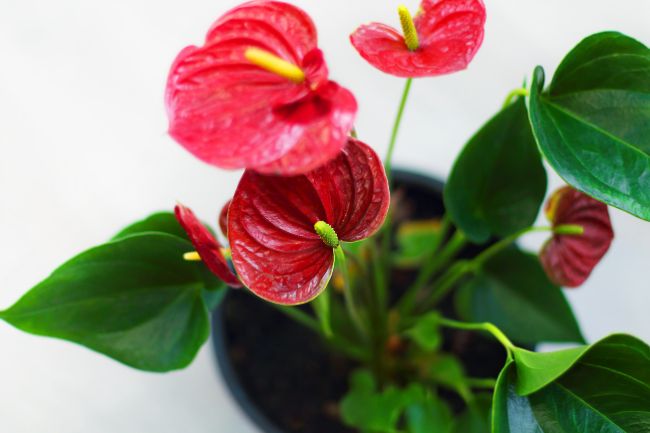
For houseplants with red flowers, it’s really hard to go past anthuriums. They are one of my favorites due to the blooms that go on forever. Although they can sometimes be a little tricky to keep in great shape, their exotic blooms and intricate foliage make them worth the effort.
Growing about 25 centimeters tall, the Flamingo Flower, or Pigtail Plant blooms with flat waxy flowers that are in fact modified leaves called bracts. The flowers are actually really tiny and on the central stem, or spadix, to give it its proper name.
Anthuriums tolerate a wide temperature range of 60°F to 90°F (15°C to 32°C), need moderate to high humidity, bright filtered light, and careful watering to keep them looking their best. Keep them away from both warm and cold drafts. Read more about why anthuriums are such a fantastic houseplant, and how to care for them here.
Guzmania (Guzmania spp.)
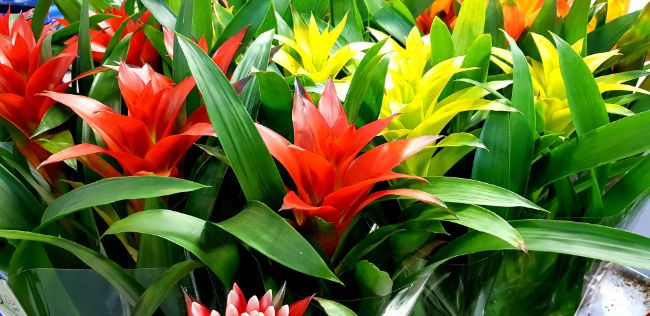
A type of bromeliad, Guzmania is known as a prized, easy to care for, houseplant outside of its native South America and are grown for their showy flower displays. Leaves are thin and dark green; striking red bracts grow in a spike-type inflorescence from the center of the plant.
Plants prefer indirect light conditions because of their origin in the rainforest, growing attached to trees. Avoid direct sunlight to prevent leaf scorching and keep the potting soil consistently moist, but not soggy. Place filtered or distilled water in the central cup of the plant, replacing it frequently with clean water to prevent fungal growth. Read my Guzmania care guide here.
Hibiscus (Hibiscus spp.)
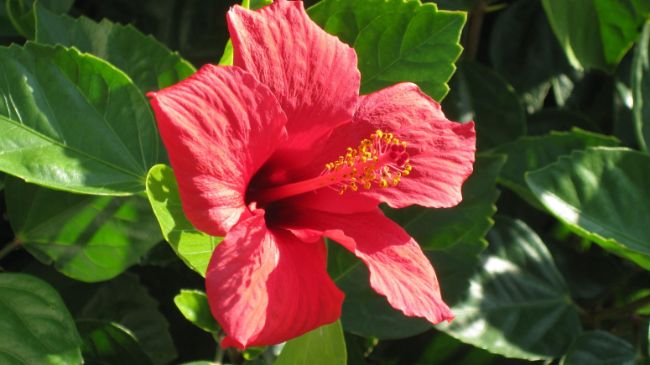
Typically grown outdoors, hibiscus plants make a great addition to a sunny windowsill, so are an essential addition to my list of houseplants with red flowers. The large papery flowers on a hibiscus may only last for a day or two before they drop, but when cared for properly your plant will bloom in succession from spring through autumn.
Shade plants from the hot afternoon sun, keep the potting soil moist at all times but do not overwater it, and mist the leaves occasionally. Repot your plant in the spring every year to prevent it from becoming root-bound.
Lipstick Plant (Aeschynanthus radicans)
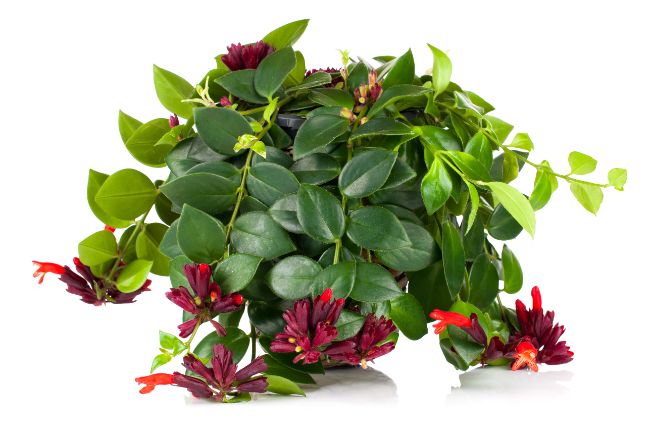
With a characteristic flower shape and descriptive common name, it’s easy to see why this beauty is called the Lipstick Plant. Tubular, two-inch flowers arise from brown “lipstick” cases and sit atop leathery leaves on trailing stems.
These plants are perfect for hanging baskets or suspended containers. Stems reach up to several feet in length and flower profusely between June and September. After they have finished flowering cut the stems back to prevent straggly growth and let them rest through the winter in a cooler location (55 to 65 degrees is best) to trigger flowering the following growing season. Read how to keep a lipstick plant healthy and blooming profusely in this article.
Nivosa Cactus (Parodia nivosa)
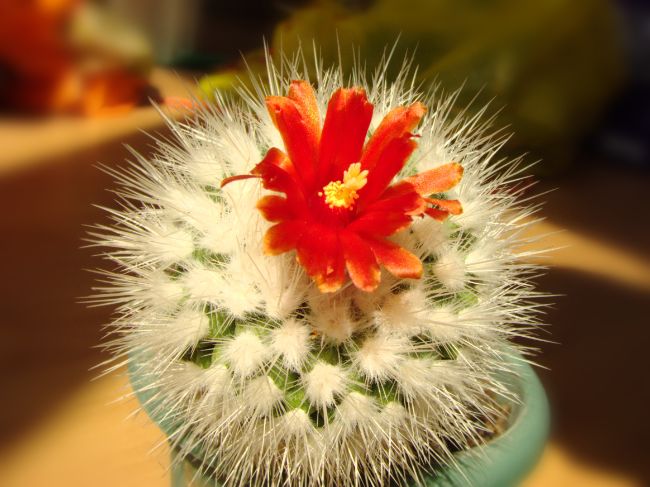
Parodia nivosa is my desert cactus representative on this list of houseplants with red flowers. When found in its natural habitat, the Nivosa, or powder puff, cactus is a spherical, dull-green cactus that blooms in the spring with funnel-shaped, bright red flowers. Dense white spines serve as protection against animals looking for water in the desert environment.
To grow Nivosa cacti indoors place them in a bright light location, such as a southern-exposure window while protecting them from drafts. Avoid overwatering. Water when the top of the potting mix is drying, thoroughly wetting the root ball.
Phalaenopsis Orchids (Phalaenopsis spp.)
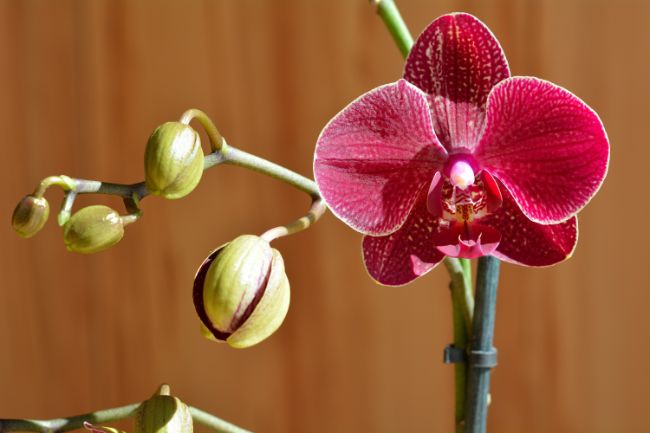
Many people believe that orchids are tricky plants to grow indoors, and this is untrue for many varieties you can purchase at your local nursery. Phalaenopsis orchids are actually quite tough and hardy, adapting to a variety of growing conditions. Their stunning appearance and colors add a bright accent to interiors. Phalaenopsis, or moth orchids, have flat-faced flowers about 2 inches across.
Unlike other houseplants, orchids are not grown in potting soil but instead are best planted in an orchid mix containing pine bark, and amendments such as LECA and perlite, to provide exceptional drainage. Orchids prefer to be kept on the drier side and need plenty of air in the root zone, so avoid overwatering.
One of my all-time favorite houseplants, that comes in a wide variety of colors. I’ve written about phalaenopsis orchids extensively on this site. If you’d like to learn more, start with my phalaenopsis orchid care for beginners article.
Sky Plant (Tillandsia ionantha)
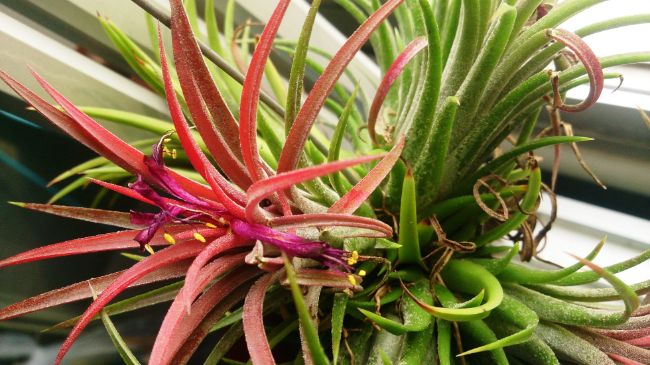
For someone looking for an incredibly low maintenance plant, the Sky Plant (Tillandsia ionantha) is a great choice. Unlike most houseplants, this plant can grow without the traditional combination of containers and potting soil. A small evergreen epiphyte, it reaches no more than 5 inches in height. Rosettes of silvery-green leaves turn deep green when mature; the inner leaves turn bright red when a flower spike is produced.
Keep them out of direct sunlight, and mist them daily to give them lots of humidity. Besides that, the Sky Plant doesn’t require any other care. Their native habitat is growing on rock faces or hanging from trees from Mexico to Nicaragua.
Wax begonia (Begonia x semperflorens-cultorum)
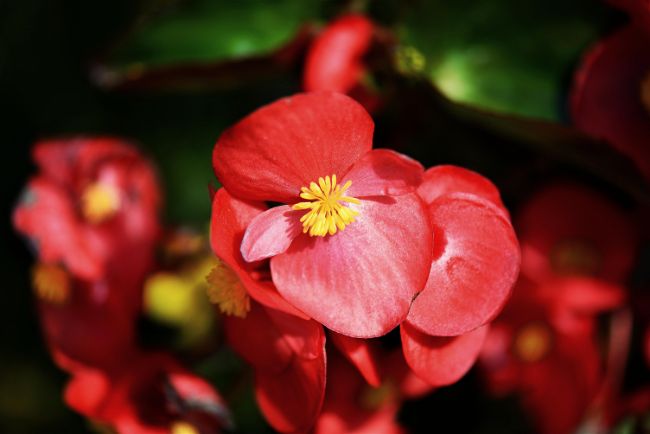
These tough little plants barely grow a foot tall, but their stunning red flowers and easy to grow nature make them a great container plant for indoors. Hybrids have been developed with foliage colors ranging from greenish-yellow to the deepest shades of red. Wax begonias bloom any time of the year – many gardeners dig up bedding plants in the autumn and move them indoors as container plants for the winter.
A hardy perennial plant, give your wax begonia as much sunlight as possible. Water when the top of the potting soil starts to dry out, being careful to not overwater. Deadhead spent blooms and pinch back leggy stems to encourage full, bushy growth and continuous flowering.
Last Word
I hope you’ve enjoyed this list of my favorite houseplants with red flowers. If you’re looking for something easy to care for, you can’t go wrong with a Flaming Katy or Guzmania. They are so cheerful and bloom for months. If you’re up for more of a challenge, then the Lipstick plant gets my seal of approval. Having said that, each plant on this list has its own charms, and I’ve enjoyed caring for every single one.

